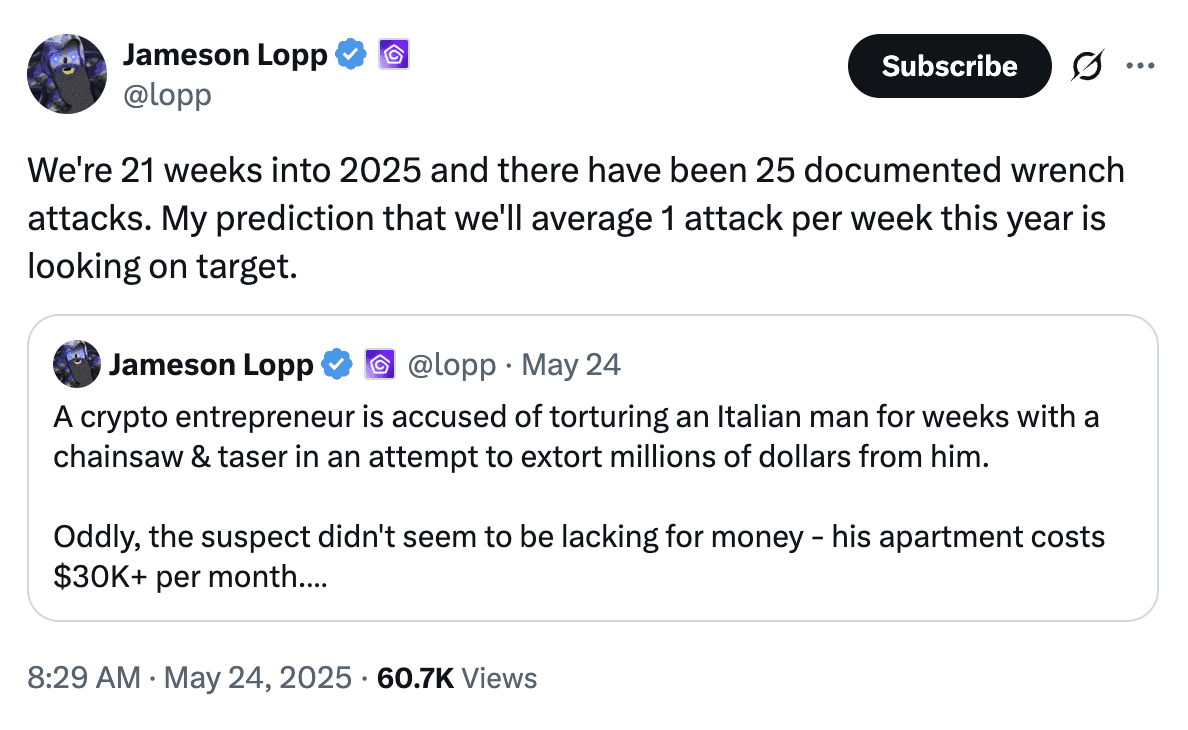A third individual, William Duplessie, 33, surrendered to the New York Police Department (NYPD) on May 27 in connection with the kidnapping, torture, and attempted extortion of Michael Valentino Teofrasto, an Italian tourist. Duplessie faces charges of “kidnapping and false imprisonment of an associate,” according to NYPD Commissioner Jessica Tisch. This incident is part of a worrying trend of kidnappings targeting crypto investors and their assets.
Key Takeaways:
- Third Arrest: William Duplessie is the third suspect arrested in the case.
- Charges: He is charged with kidnapping and false imprisonment.
- Victim: Michael Valentino Teofrasto, an Italian tourist, was the victim.
- Motive: The crime appears to be related to cryptocurrency extortion.
- Trend: This incident is part of a growing trend of kidnappings targeting crypto investors.
The arrest comes amid heightened concerns about the safety and security of crypto investors, with industry executives and individuals taking additional security measures.
According to reports from The New York Times, Duplessie and John Woeltz, another suspect previously arrested in the case, had connections to a New York City-based crypto hedge fund. The exact nature of their involvement and the hedge fund’s connection to the crime are still under investigation.

Duplessie reportedly negotiated his surrender with the NYPD in the days leading up to his arrest. Details of these negotiations have not been publicly released.
The Kidnapping and Torture of Michael Valentino Teofrasto
Michael Valentino Teofrasto, 28, was kidnapped in Manhattan and held captive for several weeks. During his captivity, he was subjected to brutal treatment in an attempt to force him to reveal his cryptocurrency private keys. The methods used included:
- Physical Restraint: Teofrasto was bound and held against his will.
- Theft: His passport and mobile device were stolen.
- Physical Assault: He was physically beaten, including being shocked with a Taser.
- Waterboarding Simulation: Suspects submerged his feet in water while tasing him.
Teofrasto managed to escape from the luxury townhome in the SoHo neighborhood of Manhattan where he was being held. After escaping, he flagged down a police officer and reported the crime.
Following Teofrasto’s report, the NYPD arrested John Woeltz, charging him with kidnapping for ransom and other felony counts. Woeltz is currently being held without bail while awaiting trial, and he is expected to appear in court for an additional hearing on May 28.
Update Another suspect has been arrested in the case, it is unknown if there are additional suspects that have yet to be apprehended. In light of this ongoing case, what can crypto users do to protect themselves?
Protecting Yourself from Crypto-Related Kidnappings and Extortion
Given the increasing number of incidents targeting crypto investors, it’s essential to take proactive measures to protect yourself:
- Enhanced Security Measures: Implement robust security measures for your cryptocurrency holdings. This includes using hardware wallets, enabling two-factor authentication (2FA), and storing private keys offline.
- Discretion: Avoid publicly disclosing your cryptocurrency holdings or wealth. Be cautious about sharing information online or with individuals you don’t fully trust.
- Vigilance: Be aware of your surroundings and trust your instincts. If something feels off, remove yourself from the situation immediately.
- Travel Security: If traveling, especially with significant cryptocurrency holdings, consider hiring security personnel or informing local authorities of your presence.
- Emergency Plan: Develop an emergency plan in case of a kidnapping or extortion attempt. This plan should include contact information for law enforcement, legal counsel, and trusted family members or friends.
- Insurance: Explore the possibility of obtaining cryptocurrency insurance policies that cover losses due to theft, extortion, or other security breaches.
The Bigger Picture: Crypto-Related Crime
The kidnapping of Michael Valentino Teofrasto is just one example of the growing number of crimes targeting cryptocurrency investors. Other types of crypto-related crime include:
- Phishing scams: Scammers use fake emails or websites to trick people into revealing their private keys or login credentials.
- Malware: Malware can be used to steal cryptocurrency from victims’ computers or mobile devices.
- Ransomware: Ransomware encrypts victims’ files and demands a ransom payment in cryptocurrency to decrypt them.
- Pump-and-dump schemes: Scammers artificially inflate the price of a cryptocurrency and then sell their holdings at a profit, leaving other investors with losses.
Law enforcement agencies are working to combat crypto-related crime, but it is essential for individuals to take proactive steps to protect themselves. By taking the necessary precautions, you can significantly reduce your risk of becoming a victim of crypto-related crime.